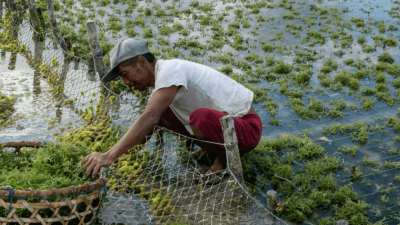
Transforming shipping for climate, people and nature
Transforming shipping for climate, people and nature
This page is approximately a 4 minute read
This page was published on

tonnes of seaweed is cultivated in Asia each year
Stats show that almost one billion people are starving, and there are an additional 215,000 mouths to feed each year. Cities continue to grow, eating into arable lands, while our food systems have become the biggest contributor to climate change, water scarcity, soil depletion, biodiversity loss and modern slavery.
Something needs to change, yet despite the problems increasing year-on-year, the solutions are few and far between. If we are serious about taking action to protect the future of our planet, then we must look towards our oceans. Despite covering 70% of the planet, oceans contribute just 2% of our food in calories. To create real change, the world’s leaders and scientists should turn their attention to seaweed.
Possibly the greatest untapped resource on the planet, seaweed regroups a wide range of organisms. In fact, when green seaweed moved on land half a billion years ago, it gave birth to all the vegetation we have now, yet we have stopped short of realising its full potential. Many countries across the world seem oblivious to seaweed’s many properties.
When looking for inspiration on how we can better use seaweed, we can look towards Asia. After starting its seaweed revolution 60 years ago, Asia is now cultivating 35 million tonnes of the plant each year. Why? Because seaweed is a highly nutritious ingredient. As all well as being full of protein, seaweed is a good source of iodine, zinc, vitamin B12 and omega-3 long-chain fatty acids. It also retains all its nutrients when dried, meaning it doesn’t require cold chain storage and keeps its qualities for months.
Seaweed’s properties stretch far beyond being a source of food for human consumption and there are a number of opportunities that the world should grasp. These include:
It might sound too good to be true, but the evidence is there for all to see. Despite this, little has been done to embrace the potential of seaweed. Of the 12,000 types of seaweed in the world, we cultivate fewer than 20. There is a lack of scientific knowledge on how to sustainably grow seaweed, and more needs to be done in this area.
The seaweed sector is also highly fragmented. While the vision is there, pioneers are isolated. This started to change in 2021 with the launch of the Safe Seaweed Coalition, the world’s first global coalition of seafood organisations launched by Lloyd’s Register Foundation and the United Nations Global Compact, bringing together stakeholders to voice the needs of the industry, accelerate change safely and attract investors.
Some challenges remain, which the Coalition is aiming to tackle – especially the lack of global standards required to establish a safe, sustainable scaled-up seaweed industry. Yet, if the sector fulfilled its potential, it could also have a significant impact on revenue and jobs in coastal communities where fishing resources are sharply declining.
We must change the narrative on how we tackle the planet’s crises. We must stop feeding the next generation with fears, but rather provide them with solutions. The seaweed revolution is a source of hope. If we cultivate oceans in a regenerative way – and learn from our mistakes on land – then our children may be remembered as the first generation on the planet to feed the entire population while mitigating climate change, restoring biodiversity and reducing social injustice.
This blog is written by Vincent Doumeizel, Senior Adviser for the United Nations Global Compact and Director for the Food Programme at Lloyd’s Register Foundation. Partnering with institutions and large brands, Vincent led the “Seaweed Manifesto” in a call to scale up the seaweed industry in order to address our most pressing global challenges. He is now leading the first global platform for Seaweed Stakeholders, the Global Seaweed Coalition.
Image credits: Shutterstock / Pande Putu Hadi Wiguna